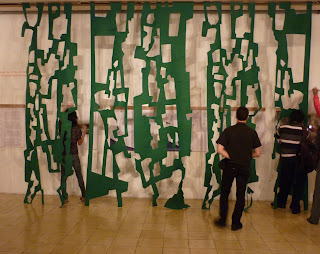This exhibiton and Presentation of Artist in Residence
24 – 30 March 2011
Discussion : 29 March 2011, Tuesday, 7.30 pm
Cemeti Art House
Jl. D.I. Panjaitan 41/ Yogyakarta.
Open : 09.00 am – 05.00 pm, Sunday, Monday closed.
Mada Van Gaans is a fashion designer who creates highly feminine, slightly futuristic, edgy women’s wear collections. Her designs are a divine mix between fantasy, luxury and comfort.
“Wearable, highly imaginative in its own, particular, yet classy way”
Her work is refined and detailed, has a whimsical and “art nauveau” touch. Strong formations, softened by flowing materials and elusive prints, are brought together within a dreamy, yet wearable range of refinded outfits suited for modern women who embrance their existence.
Natural elements and traditional craftsmanship from other cultures are placed in a new concept and show a harmonious mixture between multicultural craftsmanship and modern cloth.
Mada Van Gaans was inspired by the traditional craftsmanship of Indonesia. She researched different techniques using fabric and wood, which led to a series of experimental artworks. Mada Van Gaans’ trademark is a crown bird that stand for luck, health, immortality, faith, and hope. She translated her symbol of the crown bird in her artwork using silver and rattan. “I think it’s important to stimulate traditional handicraft and that it will be retained in this world of industrialistation”
Mada Van Gaans developed wooden dools inspired by the traditional Wayang Golek doll, the drawing doll and Pandore doll, which were used in 1756 in France to present the latest fashions to rich ladies.
Mada Van Gaans is fascinated by the symbols and myths from Java and Bali, and she explores stories about gods and demons.
She translated several characters of mythical stories. Kala Rauh is the god of all demons who represents immortality, who can be compared with powerfull people who rule that world and try to control the brains of mankind and even the planets and weather. She Looked at the ancient pattern of the Ceplok Kawung flower, which was used on outfits and sculptures of Kings and Gods. She also uses the pattern of Semen, the leaves of the Tree of Life that can be found batik and traditional; wooden door frames in Indonesia.
Mada Van Gaans (born in Sliedrecht, 1975) studied at the intermediate Technical School for Fashion and Clothing MTS in Utrecht, and the Amsterdam Fashion Institute. She did her final Masters from the Fashion Institute Arnhem and received several awards.
Harmen van de Wal graduated with honourable mentions in 1992 at de Technical University of Delft, faculty of architecture, and received an honoursable mentions for the Archiprix, the price of the Netherlands best student work in 1993.
After working as a curator for the Netherlands Architecture Institute and as designer for various urban planning offices and landscape architecture offices, He founded Krill in April 2000.
Proto Tamansari
Existing landsacape structures in cultivated Javanese agrarian areas can provide us with models for sustainable suburanization. It is with this belief that Harmen van de Wal, an architect from The Netherlands, has been conducting research in the Bantul Area. Proto Tamansari, a name reflecting both Prototype and Projo Tamansari, is a project that seeks to use the settlement layout, carefully developed over centuries to enable a transformation into modernity that outsmarts generic urban growth in terms of wate and sewage management, reducing the ‘urban heat island’ syndrome, and also allows for social sustainability.
Harmen van de wal (born in Utrecht, 1966) is co founder and current head of Krill Architecture and research . Based in Rotterdam, the Netherlands, Krill Architecture focuses on local as well as international issues.Next to his activities at Krill’s, Harmen van de Wal is lecturing at numerous academies of architecture.


















Tidak ada komentar:
Posting Komentar